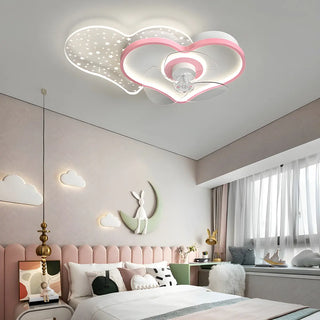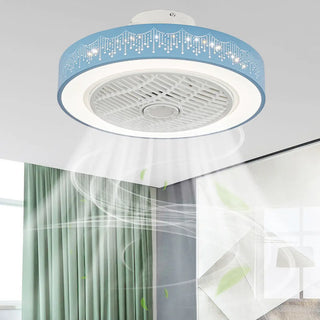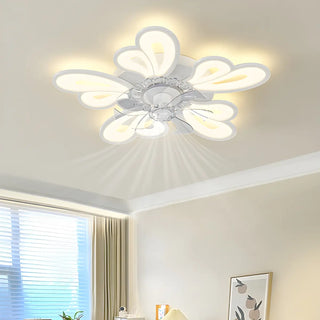What should I choose for a ceiling fan in my child's room? Standard ceiling fans are noisy and windy, disrupting their sleep. So a specially designed kids ceiling fan comes along!
What is the difference between a child ceiling fan and a regular ceiling fan? Why are they suitable for children? Let's get to know the unique features of children's ceiling fans.
Choose the right ceiling fan for your kids to make their journey happier and more joyful! So, let's find out how to choose the right kids ceiling fan for different kids in this blog!
Why Every Child’s Room Needs a Specialized Ceiling Fan
Most of the time, parents overlook the safety hazards of ceiling fans. However, standard designs do create discomfort and danger in children's spaces, such as fan blades that can fall, excessive wind and noise. There are also zippered ceiling fans that pose a strangulation hazard to curious toddlers.
Children's ceiling fans put children first. These fans have motors that prevent accidental contact with moving parts and blades made from materials that reduce the risk of injury.

In addition to safety, children's ceiling fans create a healthier environment for kids. The soft airflow of these fans helps regulate the temperature without creating harsh drafts like adult fans.
In addition, the silent operation is quiet and does not disturb children's sleep. Most ceiling fans with lights solve the problem of cooling and lighting.
You can also find a variety of nurturing designs on these fans, such as stars, clouds, and adventures that can spark the imagination of older children.
How to Choose the Right Ceiling Fan for a Kid's Room
There are many things to consider before selecting a ceiling fan for your child's space. We have discussed the most important points below for you.
1. Start with Safety Engineering
When choosing a fan for your child's room, you should keep your child's safety in mind. Prioritize fans with enclosed motors, which will prevent fingers from touching the fan.
For particularly active children, you should choose soft silicone-edged blades. This is because they can greatly reduce the risk of your child getting injured while playing. In addition, you should ensure a secure mounting system that is designed to withstand the vibrations of a bunk bed or play area;
These engineering choices directly address common dangers such as entanglement or impact injuries. By starting with these basics, you can ensure that your children are comfortable and protected.
2. Match Themes to Developmental Stages
Another consideration in purchasing a ceiling fan for a child's room is its style and design. A unique visual design should help your child grow and also complement the room's décor.
Assuming you have an infant (0-2 years old), you should choose soft natural patterns to stimulate developing eyesight. Whereas if you are decorating a room for a toddler (2-5 years), you should choose interactive themes such as friendly animals or basic shapes to encourage recognition.
We will discuss this further in the next part of the blog.
3. Optimize Noise and Airflow
At different ages, children have distinct climate needs. Nurseries require near-silent operation of under 35 decibels with gentle breezes that won't disturb sleep. So you should prioritize DC motors, known for quiet performance.
And for toddlers and older children, you should select fans with adjustable speed settings, like lower settings for quiet playtimes, higher airflow for active hours. Your kids' ceiling fan blade pitch also matters; steeper angles move air efficiently in larger rooms without harsh drafts.
However, you should avoid industrial-style fans that create disruptive "chopping" sounds.
4. Simplify Daily Use
Before purchasing a ceiling fan for your child's room, you should consider how it will actually operate. You should choose a ceiling fan with wall-mounted controls or a remote control system to avoid dangerous zippers.
Always make sure that the fan has intuitive buttons that are easy for older children to operate independently, yet lockable for toddlers.
Choose features that minimize clutter and danger while making daily adjustments a breeze.
5. Verify Certifications
Choose a fan with an ETL or UL certification, as these certifications ensure that the fan meets strict electrical safety standards.
For young children, compliance with non-toxic materials should be verified, choosing lead-free finishes and VOC-free paints. These certifications are more than just paperwork to ensure children's health.
Kids' Ceiling Fan Ideas for Different Kids' Rooms
Without a doubt, children's needs evolve as they grow. That's why every age child requires a tailored ceiling fan solution. The following recommendations for various kids' ages will give you an idea to choose a kids' ceiling fan based on their age.
1. Nursery (0-2 Years)
Childcare requires ultra-gentle temperature control, and safety and serenity should be the first priority. For this reason, you should choose a child ceiling fan with a bladeless or fully enclosed design.

Choose one that operates at less than 30 decibels to prevent sleep disruption. Many children's ceiling fans also have integrated LED soft lights that run simultaneously for satisfying use. Just like Zowala's variety of kids ceiling fans.
2. Toddler Room (2-5 Years)
Then there are toddlers, ensuring safety while giving some room for imagination. For this age group, you can opt for retractable fan blades. The fan blades stop instantly when touched, while the soft bumper edges prevent the inevitable bumps.
In these ceiling fans, the medium airflow allows air to circulate, while the simple wall switch prevents cord-related hazards. You can also find themed visuals for these fans, such as animals, vehicles, and more, to spark the imagination without causing overstimulation at bedtime.
A good example of such a fan is the Homezowala rabbit round ceiling fan with light.
3. Teen Rooms (13+ Years)
Teenagers require sophisticated styles with smart functionality. You should choose minimalist metallic or wood-finish fans that complement evolving aesthetics.
You can prioritize stronger airflow for larger bodies and adjustable settings for study/sleep cycles. Many fans also come with App-controlled operation and dimmable task lighting to support independence while eliminating dangling cords.
4. Girls’ Rooms
A girl's room needs the most sophistication and attention.
You can choose soft pastel shades such as lavender and pink for your girls' ceiling fans. Or natural patterns such as flowers and butterflies for a coherent decorative effect. Of course, with your child's favorite patterns in mind, it's a good idea to ask your child about their preferences.
Zowala's Kids Pink Heart Ring Ceiling Fan with Light is a great choice for girls; this fan features a laser-cut heart pattern that casts a delicate shadow effect. The pink and white look complements the popular color scheme of a girl's room.
5. Boys’ Rooms
Boys’ rooms benefit from high-energy themes that fuel creativity while also providing high-speed air flow. You can find fans with adventure concepts like space, dinosaurs, sports, vehicles, just like homezowala helicopter design fan with bold colors to engage active minds.
Such fans strong built fan is highly essential for rough play, while medium-to-strong airflow cools quickly after physical activities. You should make sure your boy's room fan has easy-reach controls for self-operation.
Safe Installation Tips for Kids' Ceiling Fans
For any home appliance, proper placement and installation are a crucial step to make it work the best. The below given guidelines ensure your child’s ceiling fan delivers comfort without compromising safety.
1. Always Maintain Minimum Height Requirements
You should always maintain a minimum height distance from the ceiling fan to prevent injury. To do this, install the ceiling fan at least 7 feet off the floor and at least 8-10 inches from the wall. Prevent taller children from touching the fan blades while playing or jumping.
This should be increased to at least 8 feet if the room contains bunk beds or climbing structures. Measurements should be taken from the lowest point of the blades, not from the fixture kit. If the ceiling height is less than 8 feet, select a flush mount ceiling fans that is flush with the ceiling.
2. Avoid Dangerous Placement Areas
Before installing a fan in a child's room, you should identify the dangerous areas of the room. Never place the fan over furniture such as beds, desks or bookshelves. This is because the fan blades can be easily touched by a child standing on the furniture.
Also, try to maintain a 3-foot clearance from the corners of the room where play tents or forts can be erected. Try to avoid placing it near a window to avoid direct sunlight.

3. Reinforced Structural Supports
Ceiling stability can prevent catastrophic failure. Use mounting brackets to secure children's ceiling fans directly to ceiling joists, as drywall anchors alone cannot support the dynamic weight of operation;
For older homes, an electrician should be called to check the integrity of the joists before installation.
4. Eliminate Electrical Hazards
You should also ensure that electrical wiring is safe to protect your child from electric shocks and fires.
To do this, all junction boxes in children's rooms must meet UL-recognized standards for ceiling fan supports and contain approved wire connectors.
Insulate the wires where they enter the metal box using a short-circuit-proof sleeve. You should also run wires through conduit in the attic to prevent rodent damage;
Discover The Best Kids Ceiling Fan With Zowala
Although choosing the right kids ceiling fan can feel like an ordinary thing but it can actually transform this functional necessity into a nurturing asset.
Other than being a source of air, these fans' purpose-built solutions safeguard curiosity while fostering comfort, turning ordinary rooms into environments where imaginations thrive and rest comes easily.
So you've got all you need to make a purchase for your kids' room? You should explore Zowala. Here you will find a wide range of ceiling fans for the kids' room in various themes and designs. You can also check out our blog to learn more.
FAQs
1. How often should kids' ceiling fans be inspected?
Conduct monthly checks for blade stability and retraction responsiveness. Schedule professional maintenance every 3 years to assess motor integrity and wiring safety.
2. Can these fans replace nursery night lights?
Yes. Many models like our DreamGuard Nursery Fan include dimmable LEDs that provide safe, soothing illumination without additional fixtures.
3. Are retractable blades less efficient?
Modern designs maintain airflow efficiency while prioritizing safety. Look for aerodynamic blades (e.g., PlaySafe Toddler Fan) that optimize circulation even when retracted.
















